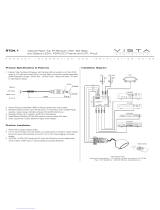Xantech MRKP2 is a full-featured zone controller designed specifically for multi-room systems based on the MX88 series, MRC88m, or MRAUDIO8x8m multi-room controllers. It allows you to select sources, control volume, mute, and power, and control all connected sources via hard buttons, its touch-screen, or its built-in IR receiver. It fits in a standard two-gang electrical back box, has a 2.4” touch-screen 16-bit Color TFT LCD display, and includes a screwless wall plate.
Xantech MRKP2 is a full-featured zone controller designed specifically for multi-room systems based on the MX88 series, MRC88m, or MRAUDIO8x8m multi-room controllers. It allows you to select sources, control volume, mute, and power, and control all connected sources via hard buttons, its touch-screen, or its built-in IR receiver. It fits in a standard two-gang electrical back box, has a 2.4” touch-screen 16-bit Color TFT LCD display, and includes a screwless wall plate.












-
 1
1
-
 2
2
-
 3
3
-
 4
4
-
 5
5
-
 6
6
-
 7
7
-
 8
8
-
 9
9
-
 10
10
-
 11
11
-
 12
12
Xantech MRKP2 User manual
- Type
- User manual
- This manual is also suitable for
Xantech MRKP2 is a full-featured zone controller designed specifically for multi-room systems based on the MX88 series, MRC88m, or MRAUDIO8x8m multi-room controllers. It allows you to select sources, control volume, mute, and power, and control all connected sources via hard buttons, its touch-screen, or its built-in IR receiver. It fits in a standard two-gang electrical back box, has a 2.4” touch-screen 16-bit Color TFT LCD display, and includes a screwless wall plate.
Ask a question and I''ll find the answer in the document
Finding information in a document is now easier with AI
Related papers
-
Xantech MRKP2E Installation Instructions Manual
-
Xantech MRKP1E User manual
-
Xantech XSSD2100W Installation Instructions Manual
-
Xantech XSS26100W Installation guide
-
Xantech Switch 282TP User manual
-
Xantech ZA8REC User manual
-
Xantech Radio RF2IR User manual
-
Xantech 48095D User manual
-
Xantech 48010D User manual
-
Xantech 283DPRO User manual
Other documents
-
 StarTech.com PLATE1WH Datasheet
StarTech.com PLATE1WH Datasheet
-
 Platinum Tools 100054C Operating instructions
Platinum Tools 100054C Operating instructions
-
Biamp Emitter Housing Variations and User manual
-
Carlon BH525H Specification
-
Carlon FN-CFB Specification
-
Encore electronic ENC-DRS User manual
-
 AVPro Edge AC-MX88-UHD* Owner's manual
AVPro Edge AC-MX88-UHD* Owner's manual
-
 Vista Acoustics RT34 Product Information And Installation Manual
Vista Acoustics RT34 Product Information And Installation Manual
-
Approx APPNBR02B Datasheet
-
Niles JobSite IR-KIT User manual















